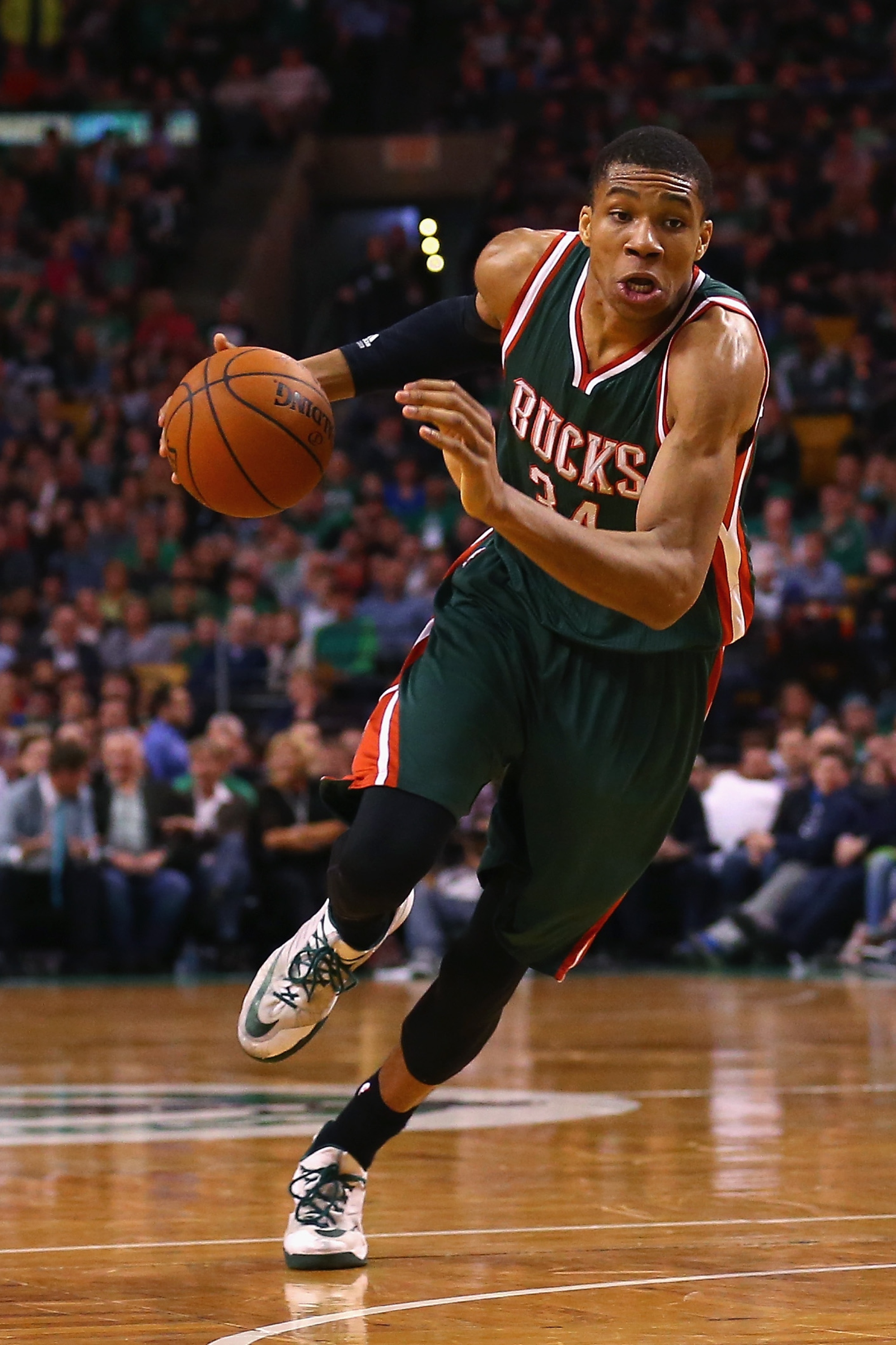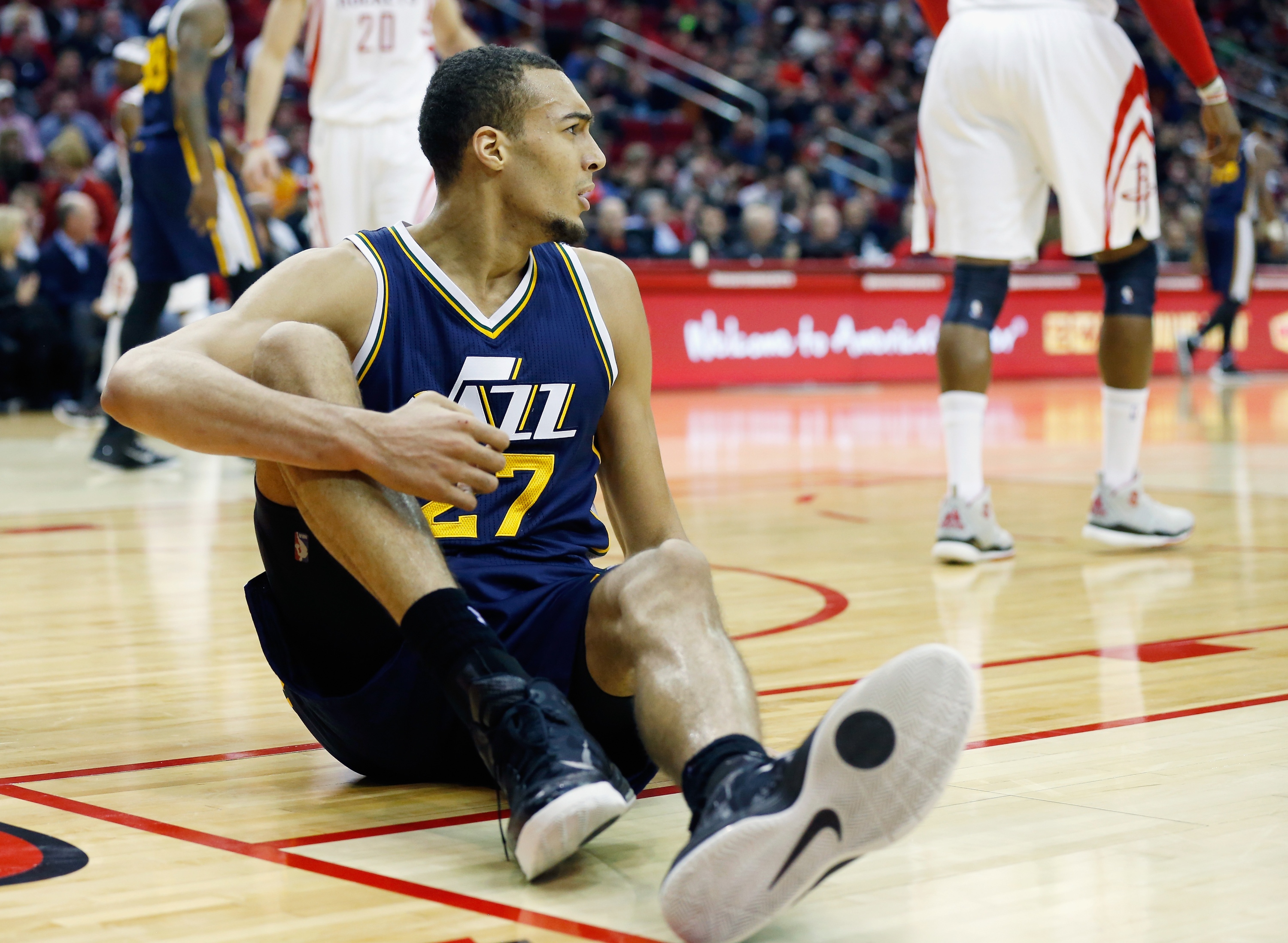Three-Man Weave: Which young player will make the biggest leap to stardom?
With the draft and the bulk of free agency now behind us, it’s time to start taking stock of what’s transpired this summer and how it all figures to impact the upcoming NBA campaign.
This week, we discuss: Which promising young player will make the biggest, Anthony Davis-like star leap in 2015-16?
***
Dan Devine: Andrew Wiggins, Minnesota Timberwolves. Granted, it might not exactly be going out on a limb to identify a former No. 1 draft pick and the reigning Rookie of the Year as a star-in-the-making, but when you’re talking about a player who can do stuff like this:
… then maybe it’s OK to skip trying to make a more clever selection.
After being picked first overall and promptly shipped to the Twin Cities, Wiggins became just the fourth player in NBA history to average at least 16 points, four rebounds and two assists per game as a teenager. The other three — LeBron James, Kevin Durant and Carmelo Anthony — represent some high-class company.
The Kansas product seemed to get more comfortable offensively as the season wore on, averaging 20 points per game on 44.6 percent shooting after the All-Star break. Some of that’s owed to Wiggins often being the lone viable option on a Minnesota team that was short on shot creators even before being decimated by injuries, but anyone watching him from late December on could see nightly proof of Wiggins’ development into a top scoring threat.
He became particularly adept at punishing smaller defenders on the block, using his size, length and quickness to attack off post-ups and get himself to the charity stripe. Wiggins averaged 7.9 free-throw attempts per game post-All-Star — the league’s fifth-best mark in that span, behind only All-Stars James Harden, Russell Westbrook and DeMarcus Cousins, and intentional foul magnet DeAndre Jordan — and converted them at a crisp 78.3 percent clip.
Wiggins also often bore responsibility for defending the opponent’s top perimeter player, a challenge that he met eagerly, albeit with mixed results. A full year of experience in navigating NBA offenses followed by a full summer of adding functional strength to fight through screens and hold his own against burlier wings ought to help the 6-foot-8 Wiggins maximize his defensive potential.
The knocks on Wiggins’ game — poor shot selection and ball-handling, an inconsistent jumper, an unflattering advanced statistical profile — have merit, and he’ll need to improve on both ends of the floor to quiet his critics. He ought to have more help this season in taking the next step, with Minnesota expecting healthy returns from table-setter Ricky Rubio, top shooting guard Kevin Martin, bruising center Nikola Pekovic, legendary leader Kevin Garnett and emerging bully swingman Shabazz Muhammad, as well as an influx of interior potency in the form of 2015 No. 1 pick Karl-Anthony Towns.
More threats elsewhere — and perhaps a more permissive attitude toward firing the long ball — could open up more driving lanes and one-on-one opportunities for Wiggins, who often saw three and four defenders late in the season as opponents disregarded his teammates. A reduced workload could lead to increased offensive efficiency. And if Wiggins doesn’t have to do everything, he can focus more on both what he already does well (like driving and dunking) and on what he doesn’t (like running pick-and-rolls, which Wolves coach Flip Saunders recently said Wiggins could do more often this season).
“[Wiggins is] a blank canvas,” Saunders told Grantland’s Zach Lowe. “Very few players enter this league with the ability to draw on that canvas and create any kind of game they want.”
In his second season, surrounded by more talent, Wiggins figures to add more color, more depth and more shading to what’s already a pretty impressive portrait. If he can keep up his late-season scoring while developing his long-distance shooting, defensive and playmaking talents — I keep thinking of how Paul George improved in Years 2 and 3 — Wiggins could find himself going from winning MVP honors at the Rising Stars Challenge to playing in All-Star Weekend’s main event in front a rabid hometown crowd.
***
Eric Freeman: Giannis Antetokounmpo, Milwaukee Bucks. The Greek Freak has been an internet darling since his first days in the league, but this season could be the one in which he goes from promising young player to legitimate star. Despite turning 20 just this past December, Antetokounmpo averaged 12.7 points on 49.1 percent shooting, 6.7 rebounds, and 2.6 assists over 31.4 minutes per game while serving as an effective member of the Bucks’ second-ranked defense. Plus, although he didn’t exactly cover himself in glory while there, Giannis got a taste of the postseason as part of the NBA’s most surprisingly successful team.
Expectations will be higher for both the Bucks (my pick as the best team to watch with fewer than five national TV appearances) and Antetokounmpo this year, although early evidence suggests that they will be able to meet them. With free agent Greg Monroe added to the roster and fellow high-potential wing Jabari Parker healthy once again, Antetokounmpo can avoid focusing only on scoring and sieze an opportunity to become a versatile, do-everything star. He is the rare player who can do almost everything on the court, including things we have never seen before:
Antetokounmpo’s highlights are so bizarre, in fact, that it’s fair to wonder if his reputation as a potential superstar outstrips his observed production to date. While his numbers are excellent for a player coming off his second, age-20 season, both Anthony Davis and Kevin Durant performed far better at the same age under similar circumstances before taking a massive leap to outright dominance in Year 3. Those players represent unfair comparisons for anyone, but that extreme can help to set reasonable expectations for Antetokounmpo in 2015-16. Even if the Bucks needed or wanted him to serve as a ball-dominant star, it’s unlikely that he could do so.
Yet that does not mean Giannis must be seen as overrated or a disappointment if he fails to increase his scoring average by a few points. Rather, it may be more prudent to view him as a player capable of making a leap similar to that of Kawhi Leonard, clearly a star even if he has yet to prove himself fully capable of taking over as one of the top two offensive players in San Antonio. Like Leonard, Antetokounmpo can make his greatest impact as a defender and occasional go-to scorer. However, Giannis also has the ability to serve as a superior facilitator — there’s a reason that the Bucks have entertained the idea of playing him as a point guard, even if it looks like an unlikely landing spot in the lineup.
In other words, tabbing Antetokounmpo as a breakout candidate this season requires expanding the idea of what makes a breakout star. He likely won’t hit the 20-points-per-game threshold, attempted only 44 3-pointers a year ago, and may not be any better than Milwaukee’s third scoring option. But Giannis can be a game-changer in myriad ways, whether by making a succession of very different plays from possession to possession, guarding multiple positions, or taking over games when necessary. He is an ideal player for an era in which versatility reigns supreme.
***
Ben Rohrbach: Rudy Gobert, Utah Jazz. This began as a pursuit of the next Anthony Davis, or rising star turning supernova, but such an exercise quickly ends with the realization that there is only one Brow. Thus began a search for an All-Star on the horizon, but that answer seemed readily apparent, too, since Kawhi Leonard’s Finals MVP and Defensive Player of the Year honors make him all but an All-Star already.
Instead, I focused on the league’s up-and-comers, those budding young talents who could submit a star turn this season — albeit not to the level of Davis or Leonard — and that list swelled with every sweep of the rosters, especially since the Bucks and Magic could each field lineups full of dynamic upstarts.
So, I narrowed that group down to one team I’ll call the All-Protostars. With apologies to Dennis Schröder, Jonas Valanciunas, Kenneth Faried, Nerlens Noel and others, here’s the depth chart I came up with …
- PG: Eric Bledsoe (age 25), Marcus Smart (21), Elfrid Payton (21)
- SG: Bradley Beal (22), Brandon Knight (23), Victor Oladipo (23)
- SF: Andrew Wiggins (20), Giannis Antetokounmpo (20), Otto Porter (22)
- PF: Draymond Green (25), Jabari Parker (20), Aaron Gordon (19)
- C: Rudy Gobert (23), Andre Drummond (22), Nikola Vucevic (24)
Obvioiusly, there’s some fudging of the positions there, but I’d roll with that starting lineup for the next decade. Now, among that group, I’d lean towards Beal or Gobert enjoying the greatest leap in 2015-16, if only because the Warriors will rely less on Green than the Wizards and Jazz will the aforementioned duo.
Even accounting for Beal’s remarkable playoff run — during which he averaged 23.4 points, 5.5 boards and 4.1 assists — I still maintain Gobert will have the greatest overall impact of any up-and-comer.
Once the Stifle Tower permanently assumed a starting role following Enes Kanter’s trade to the Oklahoma City Thunder, the Jazz owned the NBA’s best defense (by nearly five points per 100 possessions) and submitted the league’s sixth-best winning percentage, trailing only the Warriors, Clippers, Cavaliers, Spurs and Rockets. His 11.1 points (on a 60.9 True Shooting percentage), 13.4 rebounds, 2.6 blocks and 1.8 assists per game during that span accounted for a 23.3 Player Efficiency Rating and anchored Utah’s impressive turnaround.
Now, consider the 7-foot-1 Frenchman with a 9-foot-7 standing reach attempted all but 15 of his 427 shots from inside of 8 feet in 2014-15. There’s plenty of offensive room to grow beyond a 67.1 field goal percentage in the restricted area, and that’s been the primary focus of his offseason. By June, he already claimed to be knocking down midrange shots with greater regularity, and that’s before he was scheduled to work with Dirk Nowitzki’s shooting coach Holger Geschwindner in Germany over the summer.
And while Gobert didn’t require a jumper during a friendly against Ukraine on Sunday, the Jazz should take his 14 points on 10 shots (and eight rebounds) in just 14:47 of action during his summer debut for the French national team as a positive sign of his improved aggressiveness. Even with a modicum of offensive improvement, Gobert should contend for an All-Star nod this coming season, and a potential postseason run for Utah would only further launch the 23-year-old into the NBA’s next stratosphere.
More NBA coverage:
– – – – – – –
Stay connected with Ball Don’t Lie on Twitter @YahooBDL, “Like” BDL on Facebook and follow Dunks Don’t Lie on Tumblr for year-round NBA talk, jokes and more.

